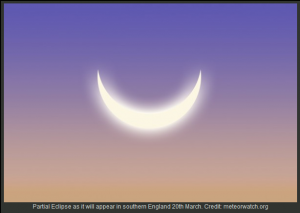On Friday March 20th (if it is not too cloudy) we will be able to view a solar eclipse. An solar eclipse is when the moon passes between the earth and the sun blocking the sun’s light from reaching the earth. This is the only total solar eclipse of 2015 and the last total solar eclipse on the March equinox occurred in 1662 on March 20th
The picture on the right shows what a total solar eclipse looks like. This will be visible in the North Atlantic. In the UK we could see a partial solar eclipse similar to the picture below.
A partial solar eclipse is when the sun, moon and earth don’t quite line up from the observer’s location.
The timing of the eclipse over the UK is around 9.30 to 9.35am on Friday 20th March. You can read more about the timings and see the progress over the UK on a map at this link.
This week, starting on Wednesday 18th March, on BBC 2 the Stargazing programme is focusing on the eclipse and includes a live broadcast on Friday morning from 9am.
If you are going to observe the eclipse it is important to do some research and make sure that you are properly prepared. There are some useful resources and activities at the Stargazing website that can be used at school or at home.
It is most important that we do not look directly at the sun, but rather use special glasses, a pinhole camera or other projection devices. Below is an idea from the Radip Times Magazine website for viewing the eclipse through a colander.
Projection through a colander
Simply hold up a kitchen colander during an eclipse and you will see that myriad small crescents – corresponding to the eclipsed phase of the Sun – are cast in the shadow. Each hole acts in the same way as a pinhole camera, projecting an inverted image of the Sun, and this works even if the holes are not round. This effect can also be seen when sunlight shines through leaves on a tree or other foliage, with the gaps between leaves acting as pinholes and creating crescents of light in the shade on the ground.
Casting the image onto a white piece of card held about 50cm away will increase the contrast, making the event easier to see, however any light-coloured surface will work. Try varying this distance to find the sharpest image, as the size of the holes in different colanders will affect the view. This method is the cheapest and easiest way for a group of people to simultaneously view the eclipse and its progress with no risk to either eyesight or equipment.
The results can be easily photographed using any conventional camera. The only downside is the size of the crescents are quite small. Increasing the distance between the colander and the projection screen will make the crescents larger, but also less defined. As such, other than the crescent itself, no details such as sunspots can be seen.
Pros: Cheap and easy, great for large groups of people
Cons: Views are quite small, no detail can be seen apart from the crescents (Radio Times staff, 2015)
If you or your school are doing anything special for the eclipse do let us know by posting in the comments below.
Reference list:
MeteorWatch (2015a) Total solar eclipse. [online] Available from: http://www.meteorwatch.org/solar-eclipse-march-20th-2015-easy-guide/#more-5998 {accessed: 17/03/15]
MeteorWatch (2015b) Partial solar eclipse. [online] Available from: http://www.meteorwatch.org/solar-eclipse-march-20th-2015-easy-guide/#more-5998 {accessed: 17/03/15]
Radio Times Staff (2015) Experience the Eclipse. [online] Available from: http://www.radiotimes.com/news/2015-03-09/how-to-watch-the-solar-eclipse [Accessed: 17/03/15]


